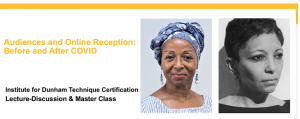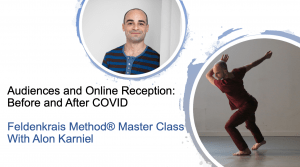
Tahribad-ı İsyan rapping from their studio in Istanbul at the virtual event on November 13, 2020
How do we experience a concert in Zoom? How do the performers convey the energy of their music on a computer screen? How do we, as audience members watching from home, choose to show that we are listening? These are some of the questions we asked and began to answer at the virtual concert presented by Turkish hip-hop group, Tahribad-ı İsyan, on November 13, 2020. The audience was made up of OSU students and faculty, as well as scholars and activists as far afield as Turkey, Germany, and Austin, TX. After a presentation about the origins of the group by their mentor and friend, activist Ms. Funda Oral (available on our Archives page), the two hip-hop artists, Asil and Burak, performed five of their hit songs and then participated in a question and answer session with the audience. When we transitioned from the presentation to the performance, I asked the audience members to consider turning their cameras on so that Asil and Burak could see them. As a teacher who made the move to online education this year due to COVID-19, I empathize with how difficult it can be to engage with a sea of black screens and the lack of physical cues or feedback.
The first song they performed, “Çamur” (Mud) (https://www.youtube.com/watch?v=czcscMoVziI), is about always remembering where you come from. As Asil and Burak traded lyrics about their neighborhood over a slow and steady beat, I put my Zoom window on gallery view so I could see the other audience members. One of my students was immediately up and dancing. Others, like me, remained seated but moved our heads, hands, or torsos to the beat. I registered pleasure and surprise on the faces of some as the song built and Burak began punctuating his rap with trills (rolled Rs). Asil and Burak couldn’t jump around the stage as usual, but they were giving it their all, dancing in their seats and performing to the camera. They went on to perform their songs, “Geri Dönemem” (https://www.youtube.com/watch?v=-alY0xb9QeQ), “Leyla” (https://www.youtube.com/watch?v=Ieb7hzIk2C8), “Ghetto Star” (https://www.youtube.com/watch?v=Ec8ejWdEgX4), and “Alev Alev” (youtube.com/watch?v=HHrdoglZ1wc). In between, they were all laughter and humble thanks, taking a few minutes to explain the next song and reach out to the audience with the few English phrases they know: “Like that!”, “Let’s go!”, “Thanks!”, “Next station.”, “That’s it.” When they were done, everyone briefly unmuted ourselves so that they could hear our applause.
During the question and answer session, Asil and Burak admitted that giving a concert online isn’t the same experience as in person, but that if they were able to transmit a bit of energy to us, they are happy. They are taking the pandemic as an opportunity to slow down and be creative, giving this time to writing new songs and recording in the studio. They hope to reach a global audience with their new album and music videos, but they also look forward to being able to perform live again, to getting together with the neighborhood kids, and to teaching hip-hop to children again. “Music is a tool,” Burak explained, “to communicate with youth across the world.”
I had asked my students to consider what is lost and what is gained in sharing live music through Zoom during the COVID-19 pandemic. Although it wasn’t the collective effervescence that artists and audience members often experience at a live hip-hop concert, this virtual experience offered a rare chance to get to know the artists and created a kind of intimacy that large concerts do not. In written responses that my students later submitted, some admitted that they found the experience awkward and didn’t feel comfortable turning on their cameras. But many others expressed positive responses. One student wrote, “It really solidified for me the idea that music is truly universal, and good music can be recognized no matter what language it may be in. This presentation made me understand just how powerful music is.” Another wrote, ” I most likely never would have had the opportunity to hear Tahribad-i Isyan perform live, so it was a special experience! I think one perk of seeing performers perform virtually is that there is less spectacle; the performances are more ‘stripped down’ and audiences are able to appreciate the talent and passion of the musicians even more because they are able to put out committed and skilled performances without having as much crowd energy off of which to play.” And one student concluded, simply, “Just like this virus, music is universal.”
(See the Archives page for the Zoom video recording and event transcript. If you would like access to the PowerPoint presentation, please email vader.6@osu.edu).






